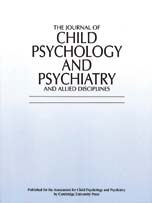Crossref Citations
This article has been cited by the following publications. This list is generated based on data provided by
Crossref.
SAFER, DANIEL J.
2000.
Commentary.
Journal of the American Academy of Child & Adolescent Psychiatry,
Vol. 39,
Issue. 8,
p.
989.
Bennett, Kathryn
2000.
SCREENING FOR EXTERNALIZING BEHAVIOR PROBLEMS.
Journal of the American Academy of Child & Adolescent Psychiatry,
Vol. 39,
Issue. 11,
p.
1341.
Campbell, Jonathan M.
Bell, Stephen K.
and
Keith, Lori K.
2001.
Concurrent Validity of the Peabody Picture Vocabulary Test-Third Edition As an Intelligence and Achievement Screener for Low SES African American Children.
Assessment,
Vol. 8,
Issue. 1,
p.
85.
DIERKER, LISA C.
ALBANO, ANNE MARIE
CLARKE, GREGORY N.
HEIMBERG, RICHARD G.
KENDALL, PHILIP C.
MERIKANGAS, KATHLEEN R.
LEWINSOHN, PETER M.
OFFORD, DAVID R.
KESSLER, RONALD
and
KUPFER, DAVID J.
2001.
Screening for Anxiety and Depression in Early Adolescence.
Journal of the American Academy of Child & Adolescent Psychiatry,
Vol. 40,
Issue. 8,
p.
929.
Scheithauer, Herbert
and
Petermann, Franz
2002.
Überblicksarbeit.
Zeitschrift für Gesundheitspsychologie,
Vol. 10,
Issue. 3,
p.
121.
Pinto-Martin, Jennifer
and
Levy, Susan E.
2004.
Early diagnosis of autism spectrum disorders.
Current Treatment Options in Neurology,
Vol. 6,
Issue. 5,
p.
391.
Pinto-Martin, Jennifer A.
Souders, Margaret C.
Giarelli, Ellen
and
Levy, Susan E.
2005.
The Role of Nurses in Screening for Autistic Spectrum Disorder in Pediatric Primary Care.
Journal of Pediatric Nursing,
Vol. 20,
Issue. 3,
p.
163.
Coonrod, Elaine E.
and
Stone, Wendy L.
2005.
Handbook of Autism and Pervasive Developmental Disorders.
p.
707.
Bailey, Susan
and
Tarbuck, Paul
2006.
Recent advances in the development of screening tools for mental health in young offenders.
Current Opinion in Psychiatry,
Vol. 19,
Issue. 4,
p.
373.
Dietz, Claudine
Swinkels, Sophie
van Daalen, Emma
van Engeland, Herman
and
Buitelaar, Jan K.
2006.
Screening for Autistic Spectrum Disorder in Children Aged 14–15 Months. II: Population Screening with the Early Screening of Autistic Traits Questionnaire (ESAT). Design and General Findings.
Journal of Autism and Developmental Disorders,
Vol. 36,
Issue. 6,
p.
713.
Ercan, Sukru
Kevern, Andrew
and
Kroll, Leo
2006.
Evaluation of a mental health website for teenagers.
Psychiatric Bulletin,
Vol. 30,
Issue. 5,
p.
175.
Watson, Linda R.
Baranek, Grace T.
Crais, Elizabeth R.
Steven Reznick, J.
Dykstra, Jessica
and
Perryman, Twyla
2007.
The First Year Inventory: Retrospective Parent Responses to a Questionnaire Designed to Identify One-Year-Olds at Risk for Autism.
Journal of Autism and Developmental Disorders,
Vol. 37,
Issue. 1,
p.
49.
CHANDLER, SUSIE
CHARMAN, TONY
BAIRD, GILLIAN
SIMONOFF, EMILY
LOUCAS, TOM
MELDRUM, DAVID
SCOTT, MIMI
and
PICKLES, ANDREW
2007.
Validation of the Social Communication Questionnaire in a Population Cohort of Children With Autism Spectrum Disorders.
Journal of the American Academy of Child & Adolescent Psychiatry,
Vol. 46,
Issue. 10,
p.
1324.
Wetherby, Amy M.
Brosnan-Maddox, Susan
Peace, Vickie
and
Newton, Laura
2008.
Validation of the Infant—Toddler Checklist as a broadband screener for autism spectrum disorders from 9 to 24 months of age.
Autism,
Vol. 12,
Issue. 5,
p.
487.
Sayal, Kapil
Letch, Nicole
and
Abd, Samaa El
2008.
Evaluation of Screening in Children Referred for an ADHD Assessment.
Child and Adolescent Mental Health,
Vol. 13,
Issue. 1,
p.
41.
Posserud, Maj-Britt
Lundervold, Astri J.
Steijnen, Maaike C.
Verhoeven, Sophie
Stormark, Kjell Morten
and
Gillberg, Christopher
2008.
Factor analysis of the Autism Spectrum Screening Questionnaire.
Autism,
Vol. 12,
Issue. 1,
p.
99.
Posserud, Maj-Britt
Lundervold, Astri J.
and
Gillberg, Christopher
2009.
Validation of the Autism Spectrum Screening Questionnaire in a Total Population Sample.
Journal of Autism and Developmental Disorders,
Vol. 39,
Issue. 1,
p.
126.
Smith, Steven R.
Little, Jessica A.
Nowinski, Lisa A.
and
Walker, Sara J.
2009.
Handbook of Clinical Rating Scales and Assessment in Psychiatry and Mental Health.
p.
287.
Jacobs, Brian
and
Taylor, Eric
2009.
Depressive Disorders.
p.
145.
Allison, Carrie
Auyeung, Bonnie
and
Baron-Cohen, Simon
2012.
Toward Brief “Red Flags” for Autism Screening: The Short Autism Spectrum Quotient and the Short Quantitative Checklist in 1,000 Cases and 3,000 Controls.
Journal of the American Academy of Child & Adolescent Psychiatry,
Vol. 51,
Issue. 2,
p.
202.


